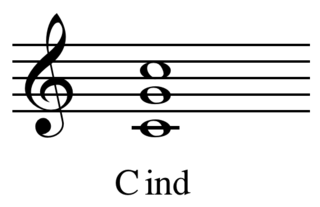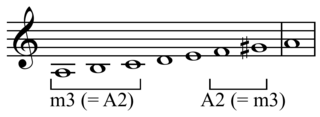
In music, counterpoint is the relationship between two or more musical lines which are harmonically interdependent yet independent in rhythm and melodic contour. It has been most commonly identified in the European classical tradition, strongly developing during the Renaissance and in much of the common practice period, especially in the Baroque period. The term originates from the Latin punctus contra punctum meaning "point against point", i.e. "note against note".

A melody, also tune, voice or line, is a linear succession of musical tones that the listener perceives as a single entity. In its most literal sense, a melody is a combination of pitch and rhythm, while more figuratively, the term can include other musical elements such as tonal color. It is the foreground to the background accompaniment. A line or part need not be a foreground melody.

In music, harmony is the concept of combining different sounds together in order to create new, distinct musical ideas. Theories of harmony seek to describe or explain the effects created by distinct pitches or tones coinciding with one another; harmonic objects such as chords, textures and tonalities are identified, defined, and categorized in the development of these theories. Harmony is broadly understood to involve both a "vertical" dimension (frequency-space) and a "horizontal" dimension (time-space), and often overlaps with related musical concepts such as melody, timbre, and form.
Schenkerian analysis is a method of analyzing tonal music based on the theories of Heinrich Schenker (1868–1935). The goal is to demonstrate the organic coherence of the work by showing how the "foreground" relates to an abstracted deep structure, the Ursatz. This primal structure is roughly the same for any tonal work, but a Schenkerian analysis shows how, in each individual case, that structure develops into a unique work at the foreground. A key theoretical concept is "tonal space". The intervals between the notes of the tonic triad in the background form a tonal space that is filled with passing and neighbour tones, producing new triads and new tonal spaces that are open for further elaborations until the "surface" of the work is reached.
In music, texture is how the tempo, melodic, and harmonic materials are combined in a musical composition, determining the overall quality of the sound in a piece. The texture is often described in regard to the density, or thickness, and range, or width, between lowest and highest pitches, in relative terms as well as more specifically distinguished according to the number of voices, or parts, and the relationship between these voices. For example, a thick texture contains many 'layers' of instruments. One of these layers could be a string section or another brass. The thickness also is changed by the amount and the richness of the instruments playing the piece. The thickness varies from light to thick. A piece's texture may be changed by the number and character of parts playing at once, the timbre of the instruments or voices playing these parts and the harmony, tempo, and rhythms used. The types categorized by number and relationship of parts are analyzed and determined through the labeling of primary textural elements: primary melody (PM), secondary melody (SM), parallel supporting melody (PSM), static support (SS), harmonic support (HS), rhythmic support (RS), and harmonic and rhythmic support (HRS).

In Western music and music theory, diminution has four distinct meanings. Diminution may be a form of embellishment in which a long note is divided into a series of shorter, usually melodic, values. Diminution may also be the compositional device where a melody, theme or motif is presented in shorter note-values than were previously used. Diminution is also the term for the proportional shortening of the value of individual note-shapes in mensural notation, either by coloration or by a sign of proportion. A minor or perfect interval that is narrowed by a chromatic semitone is a diminished interval, and the process may be referred to as diminution.

In music, a dyad is a set of two notes or pitches that, in particular contexts, may imply a chord.
In music, unified field is the 'unity of musical space' created by the free use of melodic material as harmonic material and vice versa.
Voice leading is the linear progression of individual melodic lines and their interaction with one another to create harmonies, typically in accordance with the principles of common-practice harmony and counterpoint.
In music theory, prolongation is the process in tonal music through which a pitch, interval, or consonant triad is considered to govern spans of music when not physically sounding. It is a central principle in the music-analytic methodology of Schenkerian analysis, conceived by Austrian theorist Heinrich Schenker. The English term usually translates Schenker's Auskomponierung. According to Fred Lerdahl, "The term 'prolongation' [...] usually means 'composing out' ."
In Western music and music theory, augmentation is the lengthening of a note or the widening of an interval.
The Implication-Realization (I-R) model of melodic expectation was developed by Eugene Narmour as an alternative to Schenkerian analysis centered less on music analysis and more on cognitive aspects of expectation. The model is one of the most significant modern theories of melodic expectation, going into great detail about how certain melodic structures arouse particular expectations.

In music, imitation is the repetition of a melody in a polyphonic texture shortly after its first appearance in a different voice. The melody may vary through transposition, inversion, or otherwise, but retain its original character. The intervals and rhythms of an imitation may be exact or modified; imitation occurs at varying distances relative to the first occurrence, and phrases may begin with voices in imitation before they freely go their own ways.
In music, especially Schenkerian analysis, a voice exchange is the repetition of a contrapuntal passage with the voices' parts exchanged; for instance, the melody of one part appears in a second part and vice versa. It differs from invertible counterpoint in that there is no octave displacement; therefore it always involves some voice crossing. If scored for equal instruments or voices, it may be indistinguishable from a repeat, although because a repeat does not appear in any of the parts, it may make the music more interesting for the musicians. It is a characteristic feature of rounds, although not usually called such.
In music, voice crossing is the intersection of melodic lines in a composition, leaving a lower voice on a higher pitch than a higher voice. Because this can cause registral confusion and reduce the independence of the voices, it is sometimes avoided in composition and pedagogical exercises.

A part in music refers to a component of a musical composition. Because there are multiple ways to separate these components, there are several contradictory senses in which the word "part" is used:

An incomposite interval is a concept in the Ancient Greek theory of music concerning melodic musical intervals between neighbouring notes in a tetrachord or scale which, for that reason, do not encompass smaller intervals. Aristoxenus defines melodically incomposite intervals in the following context:
Let us assume that given a systēma, whether pyknon or non-pyknon, no interval less than the remainder of the first concord can be placed next above it, and no interval less than a tone next below it. Let us also assume that each of the notes which are melodically successive in each genus will either form with the fourth note in order from it the concord of a fourth, or will form with the fifth note from it in order the concord of a fifth, or both, and that any note of which none of these things is true is unmelodic relative to those with which it forms no concord. Let us further assume that given that there are four intervals in the fifth, of which two are usually equal and two unequal, the unequal ones are placed next to the equal ones in the opposite order above and below. Let us assume that notes standing at the same concordant interval from successive notes are in succession with one another. Let us assume that in each genus an interval is melodically incomposite if the voice, in singing a melody, cannot divide it into intervals.
In music cognition, melodic fission, is a phenomenon in which one line of pitches is heard as two or more separate melodic lines. This occurs when a phrase contains groups of pitches at two or more distinct registers or with two or more distinct timbres.
This is a glossary of Schenkerian analysis, a method of musical analysis of tonal music based on the theories of Heinrich Schenker (1868–1935). The method is discussed in the concerned article and no attempt is made here to summarize it. Similarly, the entries below whenever possible link to other articles where the concepts are described with more details, and the definitions are kept here to a minimum.
Traditional sub-Saharan African harmony is a music theory of harmony in sub-Saharan African music based on the principles of homophonic parallelism, homophonic polyphony, counter-melody and ostinato-variation. Polyphony is common in African music and heterophony is a common technique as well. Although these principles of traditional African music are of Pan-African validity, the degree to which they are used in one area over another varies. Specific techniques that used to generate harmony in Africa are the "span process", "pedal notes", "rhythmic harmony", "harmony by imitation", and "scalar clusters".








